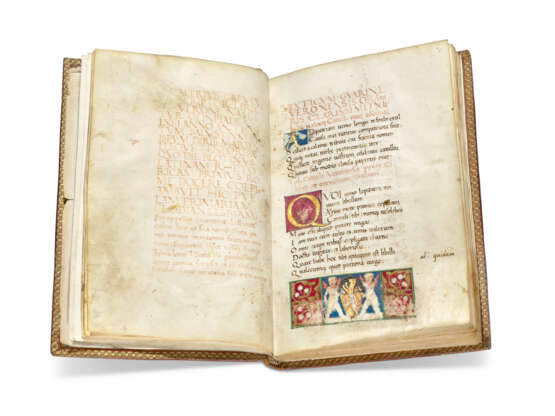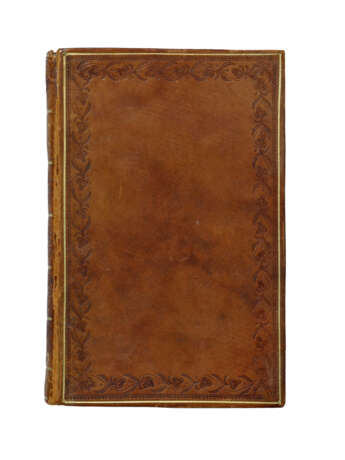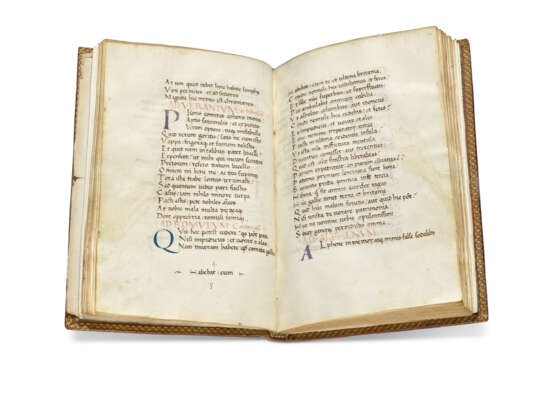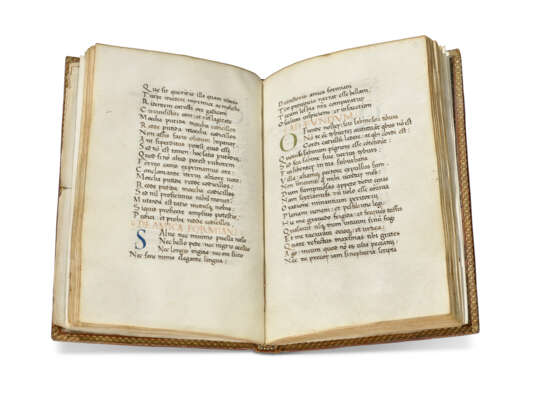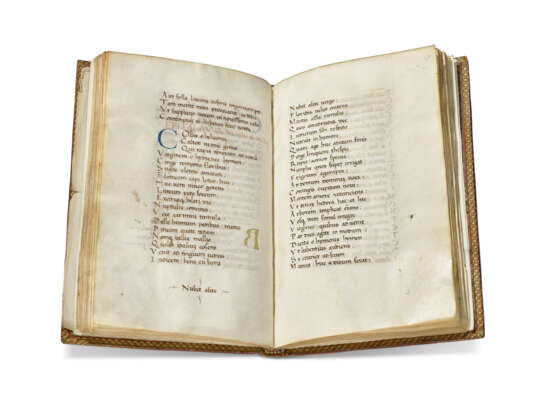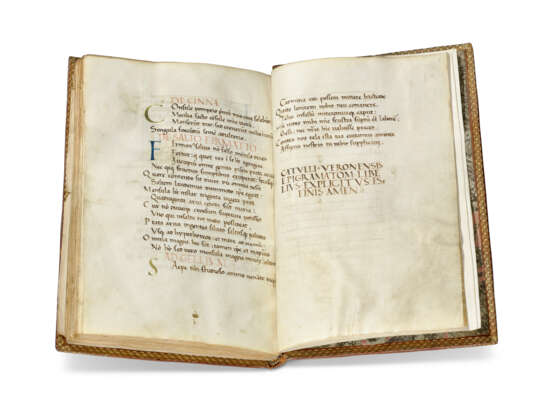ID 1214855
Lot 50 | The Squara Catullus
Valeur estimée
£ 70 000 – 100 000
Gaius Valerius Catullus, Carmina, illuminated manuscript on vellum [Italy, probably Padua, c.1475]
One of only two copies in private hands of one of the greatest of all lyric poets: Catullus. Written and owned by Bartolomeo Squara and illuminated by artists in the circle of the The Master of the Putti and the Master of the London Pliny.
176 x 110mm. ii (paper) + iv + 54 + ii (paper) leaves, complete, collation: 1-510, 64, modern foliation in pencil followed here, 22-23 lines written in a fine Humanistic minuscule with some Gothic features by Bartolomeo Squara, ruled space: 110 x 64mm, catchwords survive, pentameters indented, titles in red, mostly in capitals, often flanked by floral flourishes, eighty-one large initials in blue, olive or purple, one 4-line historiated illuminated initial with the portrait of Catullus, bas-de-page with coat of arms of the Schwarz/Squara family and putti (some craquelure and loss of pigment to the illumination and to the blue of the illuminated initial, a few marginal stains, else in excellent condition). Bound in English 19th-century blind-tooled russia gilt by Charles Lewis.
Provenance:
(1) Bartolomeo Squara, of Padua, likely written for his own use. The attribution of the hand of the scribe was made by Albinia de la Mare in the 1985 Alan Thomas catalogue. The same Bartolomeo Squara, evidently a precocious young aristocrat, also copied at the age of 14 a Liber de ingenuis moribus (Oxford, Bodleian Library, Canonicianus Misc. 87), in Padua in 1474 (he signs the manuscript 'ego bartholame sqara die gloriossissimi apostoli andree 1474 anno etatis mee xiiii'), and a Propertius now in Leiden, Bibliotheek der Rijksuniversiteit, Lipsianus 43. The same coat of arms appears here as in the Oxford manuscript: parti per fess sable on or a lion rampant countercharged, which is that of the Austrian Schwartz family. Given his young age, it would have been unlikely for Bartolomeo to be copying professionally, so it has been suggested that the name Squara could be an Italianisation of Schwartz, and that there could be links between Bartolomeo Squara and the Schwartz family. An ownership inscription on f.55v reads: 'Questo libro sie de do[mi]ni augustini [...]quara chi[...]' (Kiss, 2012, p.614 reads this 'augustini squara dni.cano'). Kiss (Kiss, 2012, p.615) notes that the Squara family is attested in Padua in 1458, with an Agostino Squara in Padua in 1464.
The manuscript opens with the biographical note on Catullus written by Girolamo Squarzafico for the editio princeps of Catullus of 1472, but Kiss notes the text is in fact copied from the 1475 Milanese edition by Philippus de Lavagnia for Johannes de Colonia and Johannes Manthen in Venice (Kiss, 2012, p.616, n.29, noting the common readings). Kiss also notes that Squara's use of the Milan incunable makes it unlikely that he would have been copying much after 1475, as the 1480s saw the appearance of two new widely circulated editions of Catullus that contained a better text. This date is consistent with the illumination and the other manuscripts copied by Squara.
(2) An early owner, writing in the margins in brown ink in a humanistic script, collated this manuscript against various printed editions in the 1490s.
(3) Francesco Mutatio (or 'Mutazzi' as suggested by Bertone, 2021): 16th-century inscription on f.1 'Munus Francisci Mutatii, P.V.'.
(4) Apparently in the collections of Giulio Saibante, 18th-century Veronese bibliophile who owned over 1,300 manuscripts, according to a pencil note by Thomas Phillipps describing it as '323 Saibanti catalogue', brought over to England by:
(5) Abbé Luigi Celotti (c.1768-1846), librarian and art dealer, sold by him at the Canonici-Saibante sale at Sotheby's 26 February 1821, lot 96, described as a paper copy, which the present is not, but must be one and the same as it was purchased by:
(6) Rev Henry Drury (1778-1841), of Harrow, bound for him by Charles Lewis: Drury's inscription on the front paper flyleaf 'H. Drury. Harrow'. Drury was a classical scholar who formed an impressive library of classical manuscripts, all bound for him by Lewis.
(7) Sir Thomas Phillipps (1792-1872), one of the greatest English bibliophiles; his MS 3400: '3400 Ph 596 / f.18-598' on verso of front marbled flyleaf and 'P1074/CAY' on rear paper flyleaf. On the acquisition of this manuscript by Phillipps, see A.N.L. Munby, Phillips Studies No. 3. The Formation of the Phillipps Library up to the Year 1840, 1954, pp.53-54. By descent to his grandson, Thomas Fitzroy Fenwick, who sold a large residue of the collection to:
(8) Lionel and Philip Robinson, booksellers of London.
(9) Sotheby's 11 December 1979, lot 45, to:
(10) Alan G. Thomas: Catalogue 47 (1985), no 1.
(11) Bruce Ferrini, of Akron, Ohio: Catalog 2 (1989), no 5, acquired by:
(12) The Schoyen Collection, MS 586.
Content:
Girolamo Squarzafico, biographical note on Catullus f.1v; Benvenuto Campesani (1250/55-1323), epigram on the rebirth of Catullus, here attributed to Guarino da Verona, beginning: 'Ad patriam venio longis [...]' f.2; Catullus, Carmina, beginning 'Quoi dono [...]' and ending 'Catulli Veronensis Epigrammatam Libelius Explicitus Est Finis Amen', ff.2-54; rulled blanks ff.54v-55.
The manuscript contains the 116 carmina of one of the greatest lyric poets of the Classical Age, Catullus. They are full of witticisms, love, scurrilous outbursts of contempt, emotional crisis, invective, playfulness, elegy and passion; they are mythological, hymnic and factual, all displaying an unrivalled level of skill, rhythm and immediacy. Several distinct poems as they appear in later printed editions are here merged into one, revealing the precarious arrangement of the Catullan corpus. Knowledge of Catullus' poetry depends entirely on a single manuscript discovered in c.1300, copied twice, and then lost. Of the two copies, one in turn was copied twice, and then lost. From the three survivors — in the Bodleian Library at Oxford, the Bibliothèque Nationale in Paris, and the Vatican Library in Rome — scholars have been able to reconstruct the lost 'archetype.' The present manuscript includes the famous Lesbia poems, including Catullus' own adaptation and translation of Sappho 31, one of Sappho's fragmentary lyric poems.
Although Catullus enjoyed a renaissance among humanist circles in Italy, with around 150 manuscripts or manuscript fragments of his poems surviving, he almost never appears on the market, and the present copy is one of only two known manuscripts of Catullus in private ownership. D.F.S. Thomson described this manuscript as belonging to his 'y' group of texts (Thomson, 1978, p.71).
Illumination:
The illumination is by an artist working in the ambit of the Putti Master and his collaborator, the Master of the London Pliny. The Putti Master, named for the charming putti that adorn his miniatures, was active in Venice between 1469-1474 and found success both as an illuminator of manuscripts and a designer of woodcuts for incunables. His collaborator and successor, the Master of the London Pliny (named for his contributions to an incunable of Pliny's Historia naturalis published by Jensen in 1472 and now in London) propagated the Putti Master's style, remaining active into the 1480s.
Literature
Bertone, S., Dispositio carminum Catulli: I carmi di Catullo nella tradizione manoscritta e a stampa dal tardo Trecento al 1535, 2021, p.219.
Kiss, D., 'Towards a catalogue of the surviving manuscripts of Catullus', Paideia, LXVII (2012), pp.612-616.
Kristeller, P.O., Iter Italicum, VI, 1992.
Thomson, D.F.S., Catullus. A Critical Edition, 1978, p.71.
| Lieu d'origine: | Italie, Europe |
|---|---|
| Catégorie maison de vente aux enchères: | Manuscrits médiévaux et de la Renaissance, Livres et manuscrits |
| Lieu d'origine: | Italie, Europe |
|---|---|
| Catégorie maison de vente aux enchères: | Manuscrits médiévaux et de la Renaissance, Livres et manuscrits |
| Adresse de l'enchère |
CHRISTIE'S 8 King Street, St. James's SW1Y 6QT London Royaume-Uni | |
|---|---|---|
| Aperçu |
| |
| Téléphone | +44 (0)20 7839 9060 | |
| Commission | see on Website | |
| Conditions d'utilisation | Conditions d'utilisation |
